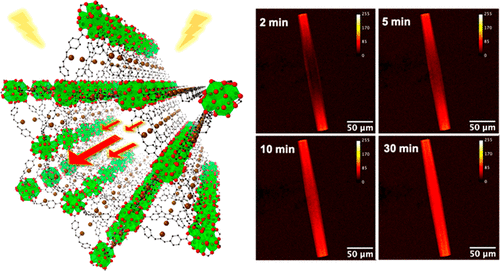Our official English website, www.x-mol.net, welcomes your
feedback! (Note: you will need to create a separate account there.)
Investigating the Process and Mechanism of Molecular Transport within a Representative Solvent-Filled Metal-Organic Framework.
Langmuir ( IF 3.7 ) Pub Date : 2020-08-25 , DOI: 10.1021/acs.langmuir.0c01999 Rui Wang 1 , Brandon C Bukowski 2 , Jiaxin Duan 1 , Thomas R Sheridan 1 , Ahmet Atilgan 1 , Kun Zhang 1, 3 , Randall Q Snurr 2 , Joseph T Hupp 1
Langmuir ( IF 3.7 ) Pub Date : 2020-08-25 , DOI: 10.1021/acs.langmuir.0c01999 Rui Wang 1 , Brandon C Bukowski 2 , Jiaxin Duan 1 , Thomas R Sheridan 1 , Ahmet Atilgan 1 , Kun Zhang 1, 3 , Randall Q Snurr 2 , Joseph T Hupp 1
Affiliation

|
Effective permeation into, and diffusive mass transport within, solvent-filled metal–organic frameworks (MOFs) is critical in applications such as MOF-based chemical catalysis of condensed-phase reactions. In this work, we studied the entry from solution of a luminescent probe molecule, 1,3,5,7-tetramethyl-4,4-difluoroboradiazaindacene (BODIPY), into the 1D channel-type, zirconium-based MOF NU-1008 and subsequent transport of the probe through the MOF. Measurements were accomplished via in situ confocal fluorescence microscopy of individual crystallites, where the evolution of the fluorescence response from the crystallite was followed as functions of both time and location within the crystallite. From the confocal data, intracrystalline transport of BODIPY is well-described by one-dimensional diffusion along the channel direction. Varying the chemical identity of the solvent revealed an inverse dependence of probe-molecule diffusivity on bulk-solvent viscosity, qualitatively consistent with expectations from the Stokes–Einstein equation for molecular diffusion. At a more quantitative level, however, measured diffusion coefficients are about 100-fold smaller than expected from Stokes–Einstein, pointing to substantial channel-confinement effects. Evaluation of the confocal data also reveals a non-negligible mass transport resistance, i.e., surface barrier, associated with the probe molecule leaving the solution and permeating the exterior surface of the MOF. Permeation by the probe entails displacement of solvent from the MOF channels. The magnitude of the resistance increases with the size of the solvent molecule. This work draws attention to the importance of MOF structure, external-surface barriers, and solvent molecule identity to the overall transport process in MOFs, which should assist in understanding the performance of MOFs in applications such as condensed-phase heterogeneous catalysis.
中文翻译:

在代表性的溶剂填充金属有机框架内研究分子运输的过程和机理。
在诸如基于MOF的缩合反应化学催化之类的应用中,有效地渗透到溶剂填充的金属有机框架(MOF)中以及在其中扩散和扩散是至关重要的。在这项工作中,我们研究了从发光探针分子溶液1,3,5,7-四甲基-4,4-二氟硼氮杂吲哚并苯(BODIPY)进入一维通道型,基于锆的MOF NU-1008和随后通过MOF传输探针。测量是通过原位完成的单个微晶的共聚焦荧光显微镜检查,其中微晶发出的荧光响应随时间和微晶内位置的变化而变化。根据共聚焦数据,通过沿通道方向的一维扩散可以很好地描述BODIPY的晶内传输。改变溶剂的化学特性可以发现探针-分子扩散率与本体溶剂粘度成反比关系,在质量上与斯托克斯-爱因斯坦方程对分子扩散的期望一致。但是,在更定量的水平上,测得的扩散系数比Stokes–Einstein的预期值要小100倍,这表明存在很大的通道限制效应。共聚焦数据的评估还显示出不可忽略的传质阻力,即 与探针分子离开溶液并渗透到MOF外表面相关的表面屏障。探针的渗透需要将溶剂从MOF通道中置换出来。电阻的大小随溶剂分子的大小而增加。这项工作引起了人们对MOF结构,外表面屏障和溶剂分子同一性对MOF中整个运输过程的重要性的关注,这应有助于理解MOF在缩合相非均相催化等应用中的性能。
更新日期:2020-09-15
中文翻译:

在代表性的溶剂填充金属有机框架内研究分子运输的过程和机理。
在诸如基于MOF的缩合反应化学催化之类的应用中,有效地渗透到溶剂填充的金属有机框架(MOF)中以及在其中扩散和扩散是至关重要的。在这项工作中,我们研究了从发光探针分子溶液1,3,5,7-四甲基-4,4-二氟硼氮杂吲哚并苯(BODIPY)进入一维通道型,基于锆的MOF NU-1008和随后通过MOF传输探针。测量是通过原位完成的单个微晶的共聚焦荧光显微镜检查,其中微晶发出的荧光响应随时间和微晶内位置的变化而变化。根据共聚焦数据,通过沿通道方向的一维扩散可以很好地描述BODIPY的晶内传输。改变溶剂的化学特性可以发现探针-分子扩散率与本体溶剂粘度成反比关系,在质量上与斯托克斯-爱因斯坦方程对分子扩散的期望一致。但是,在更定量的水平上,测得的扩散系数比Stokes–Einstein的预期值要小100倍,这表明存在很大的通道限制效应。共聚焦数据的评估还显示出不可忽略的传质阻力,即 与探针分子离开溶液并渗透到MOF外表面相关的表面屏障。探针的渗透需要将溶剂从MOF通道中置换出来。电阻的大小随溶剂分子的大小而增加。这项工作引起了人们对MOF结构,外表面屏障和溶剂分子同一性对MOF中整个运输过程的重要性的关注,这应有助于理解MOF在缩合相非均相催化等应用中的性能。











































 京公网安备 11010802027423号
京公网安备 11010802027423号